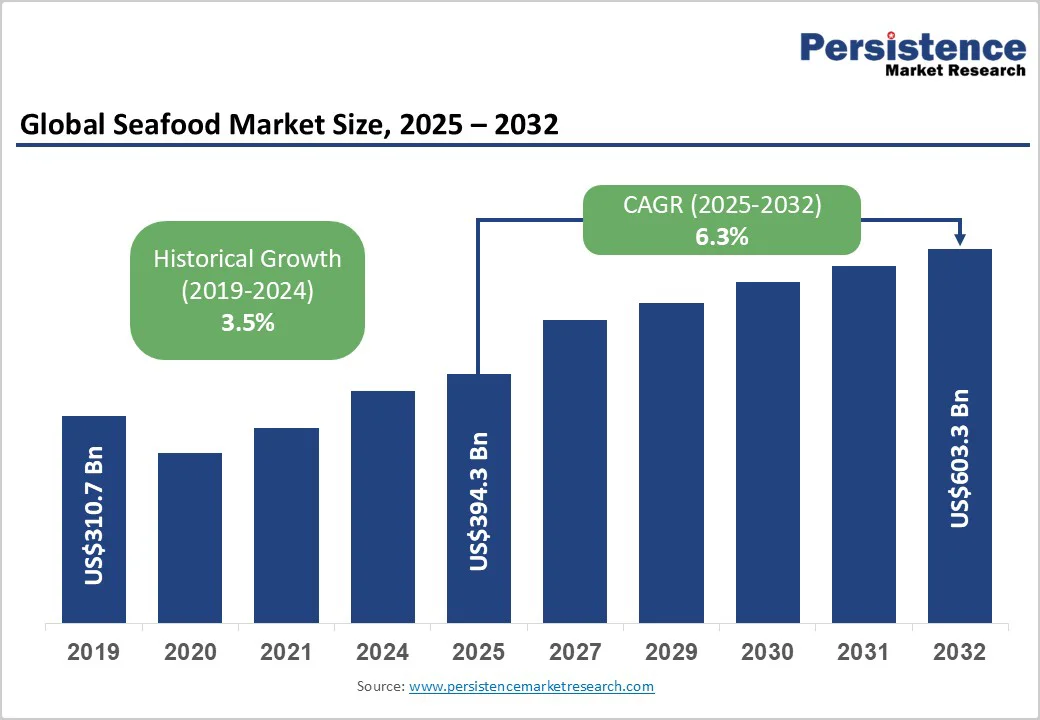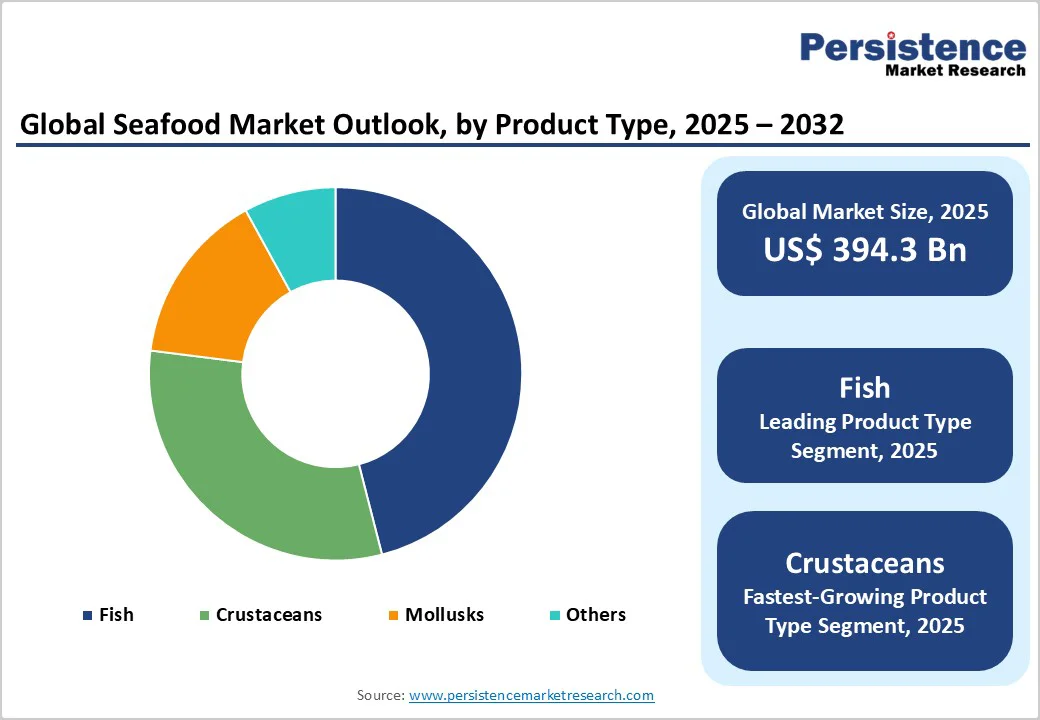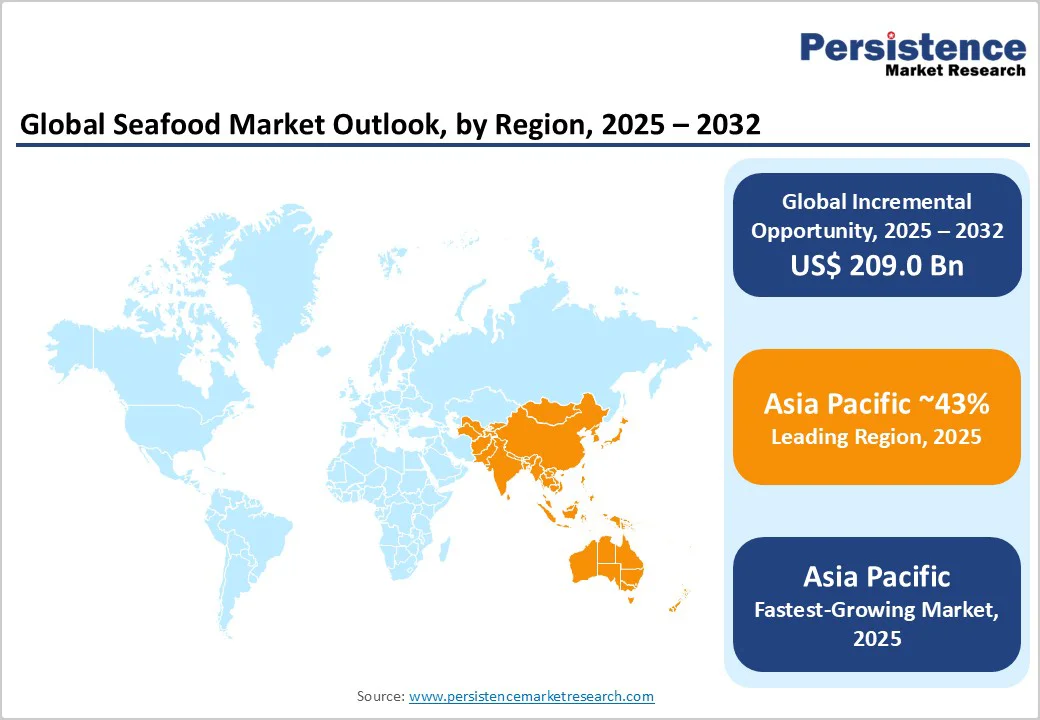ID: PMRREP33980| 196 Pages | 7 Nov 2025 | Format: PDF, Excel, PPT* | Food and Beverages

The global seafood market size is likely to be valued at US$394.3 Billion in 2025, and is estimated to reach US$603.3 Billion by 2032, growing at a CAGR of 6.3% during the forecast period from 2025 to 2032, driven by surging consumer demand for protein-rich and health-conscious diets.
Key growth drivers include rising awareness of omega-3 health benefits, rapid urbanization, and expanding retail and e-commerce access. Fish remains the leading product segment, supported by aquaculture growth.
Sustainability pressures and climate concerns are driving innovation in eco-friendly aquaculture and convenient seafood formats.
| Key Insights | Details |
|---|---|
| Seafood Market Size (2025E) | US$394.3 Bn |
| Market Value Forecast (2032F) | US$603.3 Bn |
| Projected Growth (CAGR 2025 to 2032) | 6.3% |
| Historical Market Growth (CAGR 2019 to 2024) | 3.5% |

The seafood industry is experiencing transformative growth through the integration of smart aquaculture technologies, which optimize productivity while enhancing sustainability. Industry leaders such as Cermaq and Grieg Seafood are deploying AI-enabled feeding systems, real-time water quality monitoring, and precision harvesting to stabilize output and minimize ecological impact.
These innovations are critical as climatic events such as El Niño disrupt traditional supply chains by altering ocean conditions and fish migration patterns, causing production volatility. Smart aquaculture helps mitigate such risks by enabling proactive health management and environmental control, reducing yield unpredictability. Sustainability-aligned technologies attract premium markets valuing traceability and eco-certifications.
Structural challenges in seafood supply chains are intensifying due to climate variability and geopolitical tensions, which impose operational risks and cost barriers on producers and exporters. Elevated ocean temperatures disrupt breeding and growth cycles, leading to decreased export volumes and increased price volatility.
Tariffs in key import markets such as the U.S. are inflating costs for major exporters such as Vietnam and India, potentially suppressing demand and forcing market realignments. These disruptions undermine supply chain predictability, increasing dependence on costly technology and diversification strategies to maintain volume and quality.
Consequently, industry participants face heightened risk exposure that demands adaptive investment in supply chain resilience, price risk management, and regulatory navigation to sustain competitive positioning.
Increasing consumer demand for convenience foods amid urbanization and busy lifestyles presents a lucrative growth opportunity within processed seafood formats such as frozen, canned, and ready-to-cook products. Advancements in food processing technologies and cold chain infrastructure are enabling longer shelf life and preservation of nutritional quality, aligning well with millennials and working populations seeking healthy yet time-efficient meal options.
The processed seafood segment is expanding rapidly, supported by product innovation exemplified by flavored canned tuna and unique frozen offerings that cater to evolving tastes. Capitalizing on this trend through strategic product development and distribution channel expansion can capture unmet consumer needs while diversifying revenue streams.
Fish remains the cornerstone of the market, accounting for an estimated 46% revenue share in 2025 due to its nutritional profile, versatile culinary uses, and established supply ecosystems. Varieties such as salmon, tuna, and cod lead in revenue contribution, supported by both traditional wild-caught fisheries and increasingly sophisticated aquaculture operations.
This segment benefits from broad consumer awareness of health benefits, including omega-3 fatty acids, driving steady demand within both retail and foodservice channels.
Crustaceans are emerging as the dynamic growth engine, expected to register a robust CAGR of approximately 7.2% through 2032. Drivers for this segment include increasing consumer preference for shellfish in gourmet and casual dining, coupled with expanded aquaculture farming of shrimp and lobster in Asia Pacific and Latin America.
Premium pricing and the rising global middle class’s affinity for luxury seafood dishes underpin this segment’s accelerated trajectory. Economic growth in emerging markets is anticipated to further solidify the position of crustaceans, creating lucrative opportunities for exporters and processors.
Fresh seafood is likely to dominate with around 61% of the revenue share in 2025, reflecting consumer preference for natural flavor, superior texture, and higher perceived nutritional value. The market leadership of this segment is reinforced by expanding cold chain infrastructure, especially in developed economies, which preserves freshness across distribution networks.
Processed seafood, including frozen, canned, and ready-to-cook formats, is the fastest-growing form segment from 2025 to 2032. This growth is driven by the massive scale of urbanization, increasingly busy lifestyles, and technological improvements in packaging and preservation that extend product shelf life without compromising quality. Accelerating demand among millennials and Gen Z consumers for convenience foods underpins this trend, prompting seafood producers to innovate product portfolios.
Wild-caught seafood is slated to retain a dominant market share, estimated at 57% in 2025, rooted in deep-sea fishing traditions and wide availability across major exporting countries. Aquaculture or farmed seafood is distinctly the fastest-growing source segment, with forecast CAGR exceeding 7% through 2032. Growth is powered by technological advancements such as recirculating aquaculture systems, improved fish feed formulations, and automated monitoring, which increase yield and reduce environmental impact.
Governmental support policies and sustainability certifications are incentivizing expansion of aquaculture operations globally, helping to alleviate pressure on wild fish stocks while satisfying escalating protein demand. Consequently, the ascent of aquaculture is reshaping supply chains and investment priorities across the seafood industry.

North America is expected to command an estimated 18.5% of the seafood market share in 2025, predominantly driven by the U.S., which represents over 70% of regional consumption. Market growth in this region is supported by a robust innovation ecosystem emphasizing sustainable practices, traceability, and premiumization, alongside increased consumer engagement with the health functionalities of seafood proteins.
Regulatory enforcement by bodies such as the U.S. Food and Drug Administration (FDA) and the National Oceanic and Atmospheric Administration (NOAA), guiding product safety, import standards, and environmental conservation, though these factors also elevate compliance complexity and costs for businesses.
E-commerce and direct-to-consumer models are expanding rapidly, enhancing accessibility. The seafood market in North America is forecasted to grow at a CAGR of approximately 5.2% from 2025 to 2032, driven by increasing demand for diversified seafood formats and sustainability credentials. Investments are also channeled into aquaculture technologies and cold chain improvement to manage supply chain risks.
Europe is estimated to hold a 21% market share in 2025, with significant contributions from Germany, the U.K., France, and Spain. This market is characterized by sophisticated consumer preferences, with heightened demand for organic, eco-labelled, and traceable seafood products. Regulatory harmonization through European Union (EU) policies supports stringent sustainability standards and market transparency, influencing supply chain models and product innovation.
Countries such as Norway and Scotland lead in aquaculture output, fortifying regional seafood self-sufficiency. The market in Europe is anticipated to grow at a projected CAGR through 2032, with momentum rooted in public health trends, environmental awareness campaigns, and innovation in processing and packaging technologies. Sector investment is focused on sustainable farming practices, cold chain infrastructure, and value-added product development.
Asia Pacific dominates globally with an approximate 43.5% market share in 2025, underscored by strong consumption patterns in China, Japan, India, and ASEAN countries. Rapid urbanization, rising disposable incomes, and food culture deeply integrated with seafood catalyze demand.
The regional market benefits from extensive aquaculture operations, representing over 60% of world aquaculture production, driven by China and Vietnam. Manufacturing and supply chain advantages, including cost efficiencies and government incentives, are attracting major investments.
Burgeoning middle classes seeking convenience and health-oriented seafood products are anticipated to drive market growth. Regulatory evolution, particularly concerning food safety and sustainability, is ongoing, shaping market access and export dynamics. Regional players are actively engaging in technology adoption and expansion into processed seafood segments.

The global seafood market reflects a moderately concentrated competitive structure, led by a handful of multinational corporations that cumulatively control about 32% of the market share. Mowi ASA is the largest player, leveraging comprehensive vertical integration from hatchery to retail, enabling quality control and supply consistency.
Nippon Suisan Kaisha (Nissui) and Maruha Nichiro leverage diversified product portfolios and global distribution networks to enhance market reach. Thai Union Group is notable for its innovation in processed seafood brands and sustainability commitments.
These leaders strategically engage in aquaculture expansion, R&D for product diversification, and supply chain digitalization. However, the presence of numerous regional and local players contributes to industry fragmentation, maintaining competitive dynamics particularly in niche and emerging markets.
The seafood market is projected to reach US$394.3 Billion in 2025.
Increasing awareness of omega-3 health benefits, unprecedented urbanization, and the expansion of retail and e-commerce channels, facilitating broader accessibility to seafood varieties, are driving the market.
The seafood market is poised to witness a CAGR of 6.3% from 2025 to 2032.
Climate variability and sustainability goals are driving innovation in aquaculture and sourcing, while demand for convenient seafood formats is reshaping consumer behavior and opening new market opportunities.
Mowi ASA, Nippon Suisan Kaisha Ltd (Nissui), and Maruha Nichiro Corporation are a few of the key players in the seafood market.
| Report Attribute | Details |
|---|---|
| Historical Data/Actuals | 2019 - 2024 |
| Forecast Period | 2025 - 2032 |
| Market Analysis | Value: US$ Bn |
| Geographical Coverage |
|
| Segmental Coverage |
|
| Competitive Analysis |
|
| Report Highlights |
|
By Product Type
By Form
By Source
By Region
Delivery Timelines
For more information on this report and its delivery timelines please get in touch with our sales team.
About Author